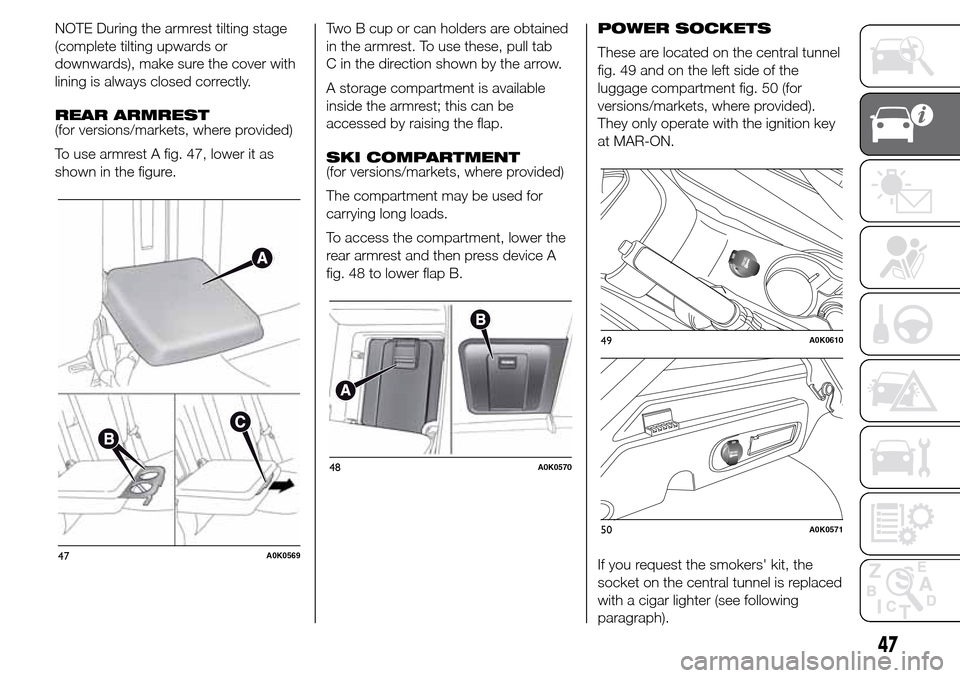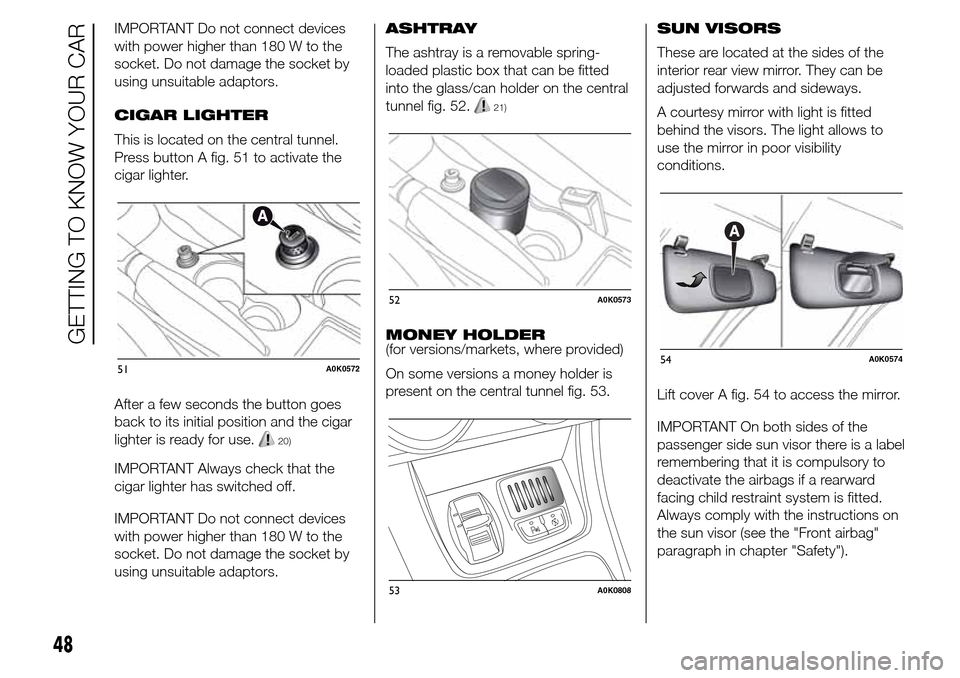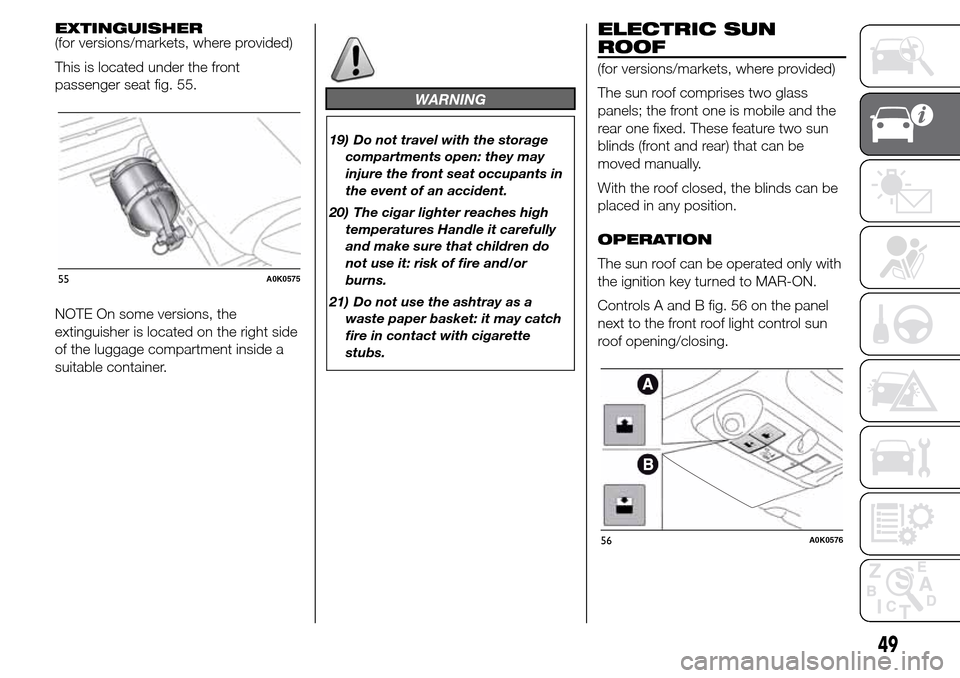2015 Alfa Romeo Giulietta light
[x] Cancel search: lightPage 51 of 288

NOTE During the armrest tilting stage
(complete tilting upwards or
downwards), make sure the cover with
lining is always closed correctly.
REAR ARMREST
(for versions/markets, where provided)
To use armrest A fig. 47, lower it as
shown in the figure.Two B cup or can holders are obtained
in the armrest. To use these, pull tab
C in the direction shown by the arrow.
A storage compartment is available
inside the armrest; this can be
accessed by raising the flap.
SKI COMPARTMENT
(for versions/markets, where provided)
The compartment may be used for
carrying long loads.
To access the compartment, lower the
rear armrest and then press device A
fig. 48 to lower flap B.POWER SOCKETS
These are located on the central tunnel
fig. 49 and on the left side of the
luggage compartment fig. 50 (for
versions/markets, where provided).
They only operate with the ignition key
at MAR-ON.
If you request the smokers' kit, the
socket on the central tunnel is replaced
with a cigar lighter (see following
paragraph).
47A0K0569
48A0K0570
49A0K0610
50A0K0571
47
Page 52 of 288

IMPORTANT Do not connect devices
with power higher than 180 W to the
socket. Do not damage the socket by
using unsuitable adaptors.
CIGAR LIGHTER
This is located on the central tunnel.
Press button A fig. 51 to activate the
cigar lighter.
After a few seconds the button goes
back to its initial position and the cigar
lighter is ready for use.
20)
IMPORTANT Always check that the
cigar lighter has switched off.
IMPORTANT Do not connect devices
with power higher than 180 W to the
socket. Do not damage the socket by
using unsuitable adaptors.ASHTRAY
The ashtray is a removable spring-
loaded plastic box that can be fitted
into the glass/can holder on the central
tunnel fig. 52.
21)
MONEY HOLDER
(for versions/markets, where provided)
On some versions a money holder is
present on the central tunnel fig. 53.SUN VISORS
These are located at the sides of the
interior rear view mirror. They can be
adjusted forwards and sideways.
A courtesy mirror with light is fitted
behind the visors. The light allows to
use the mirror in poor visibility
conditions.
Lift cover A fig. 54 to access the mirror.
IMPORTANT On both sides of the
passenger side sun visor there is a label
remembering that it is compulsory to
deactivate the airbags if a rearward
facing child restraint system is fitted.
Always comply with the instructions on
the sun visor (see the "Front airbag"
paragraph in chapter "Safety").
51A0K0572
52A0K0573
53A0K0808
54A0K0574
48
GETTING TO KNOW YOUR CAR
Page 53 of 288

EXTINGUISHER
(for versions/markets, where provided)
This is located under the front
passenger seat fig. 55.
NOTE On some versions, the
extinguisher is located on the right side
of the luggage compartment inside a
suitable container.
WARNING
19) Do not travel with the storage
compartments open: they may
injure the front seat occupants in
the event of an accident.
20) The cigar lighter reaches high
temperatures Handle it carefully
and make sure that children do
not use it: risk of fire and/or
burns.
21) Do not use the ashtray as a
waste paper basket: it may catch
fire in contact with cigarette
stubs.
ELECTRIC SUN
ROOF
(for versions/markets, where provided)
The sun roof comprises two glass
panels; the front one is mobile and the
rear one fixed. These feature two sun
blinds (front and rear) that can be
moved manually.
With the roof closed, the blinds can be
placed in any position.
OPERATION
The sun roof can be operated only with
the ignition key turned to MAR-ON.
Controls A and B fig. 56 on the panel
next to the front roof light control sun
roof opening/closing.
55A0K0575
56A0K0576
49
Page 60 of 288

LUGGAGE
COMPARTMENT
The luggage compartment unlocking is
electrically operated and is deactivated
when the car is in motion.
OPENING
When unlocked, the luggage
compartment can be opened from
outside the car by pressing the electric
logo fig. 63 until a click, which indicates
unlocking, is heard or by pressing the
button on the key.
The direction indicators will blink twice
and an internal light will switch on when
the luggage compartment is opened:
the light will go out automatically when
the luggage compartment is closed.
The light switches off automatically after
a few minutes if the luggage
compartment is left open.Emergency opening
from the inside
To carry out the emergency opening
from the inside of the car, remove
the rear seat head restraints,
completely fold down the rear seats
(see paragraph “Extending the luggage
compartment”), then press on lever A
fig. 64.
CLOSING
Lower the tailgate, pressing near the
lock until you hear it click into place.
There are handles A fig. 65 inside
the tailgate to allow it to be closed more
easily.
IMPORTANT Before closing the
luggage compartment make sure that
you have the keys since the luggage
compartment is automatically locked.LUGGAGE
COMPARTMENT
INITIALISATION
IMPORTANT If the battery is
disconnected or the protection fuse
blows, the luggage compartment
opening/closing mechanism must be
initialised as follows:
❒close all the doors and the luggage
compartment;
❒Press button
on the key;
❒Press button
on the key.63A0K0068
64A0K0583
65A0K0584
56
GETTING TO KNOW YOUR CAR
Page 62 of 288

❒raise lever A fig. 69 to fold the left or
right side of the backrest and then
guide the backrest onto the cushion
(when lever A is raised, you will
see a “red band” B).Repositioning the rear
seat
Move the seat belts to the side, making
sure that they are correctly extended
and not twisted.
Raise the previously folded backrest
until you hear the click of the locking
mechanism, visually checking that the
“red band” on lever A fig. 69 has
disappeared. The “red band” indicates
that the backrest is not secured.
Finally, reposition the head restraints,
inserting them correctly into their
housings.
SECURING YOUR LOAD
The luggage compartment contains
two attachments A fig. 70
load transported
and another two attachments are
located on the rear crossmember B.
24) 25)
IMPORTANT Every attachment has a
maximum load capacity of 100 kg.
BAG HOOKS
There are also bag hooks inside the
luggage compartment.LUGGAGE RETAINING
NET
(for versions/markets, where provided)
This is useful for correctly arranging
the load and/or for transporting light
materials. The luggage retaining net is
available from Lineaccessori Alfa
Romeo.
68A0K0625
69A0K0628
70A0K0589
58
GETTING TO KNOW YOUR CAR
(for versions/markets, where provided)
for the cables than secure the
Page 65 of 288

HEADLIGHTS
LIGHT BEAM DIRECTION
The correct orientation of the headlights
is important for the driver's comfort
and safety as well as for all other road
users. This is also covered by a specific
rule of the highway code.
The headlights must be correctly
directed to ensure the best visibility
conditions for all drivers. Contact a Alfa
Romeo Dealership to have the
headlights checked and adjusted, if
necessary.
HEADLIGHT ALIGNMENT
CORRECTOR
This device works with the ignition key
in the MAR position and the dipped
headlights on.
Headlight alignment
adjustment
To adjust, press the
andfig. 74
buttons. The adjustment position is
shown on the display.
Position 0: one or two occupants in the
front seats.
Position 1: 4 people.
Position 2: 4 people + load in luggage
compartment.
Position 3: driver + maximum permitted
load stowed in the luggage
compartment.
IMPORTANT Check the alignment
every time that the load carried
changes.
IMPORTANT If the car is equipped with
Bixenon headlights, the headlight
alignment is controlled electronically, as
a consequence the
andbuttons
are not present.
FOG LIGHT ALIGNMENT
(for versions/markets, where provided)
Contact a Alfa Romeo Dealership to
have the headlights checked and
adjusted, if necessary.ADJUSTING THE
HEADLIGHTS ABROAD
The dipped headlights are aligned to
comply with the regulations of the
country of purchase. When travelling in
countries with opposite driving
direction, to avoid dazzling the drivers
on the other side of the road, you need
to cover areas of the headlight
according to the Highway code of the
country you are travelling in.
74A0K0541
61
Page 66 of 288

ESC SYSTEM
IN BRIEF
The ESC system improves the
directional control and stability of the
car in various driving conditions.
The ESC system corrects the car’s
understeer and oversteer, distributing
the brake force on the appropriate
wheels. The torque supplied by
the engine can also be reduced in
order to maintain control of the car.
30) 31) 32) 33) 34)
The ESC system uses sensors installed
on the car to determine the trajectory
that the driver intends to follow and
compares it with the car’s effective
trajectory. When the real trajectory
deviates from the desired trajectory, the
ESC system intervenes to counter the
car’s understeer or oversteer.
❒Oversteer: occurs when the car is
turning more than it should according
to the angle of the steering wheel.
❒Understeer: occurs when the car is
turning less than it should according
to the angle of the steering wheel.The ESC system also includes the
following systems:
❒EBD
❒ABS
❒CBC
❒ASR
❒HILL HOLDER
❒HBA
❒MSR
❒DST
❒“ELECTRONIC Q2” (“E-Q2”)
❒"PRE-FILL" (RAB - Ready Alert
Brake)
SYSTEM ACTIVATION
The ESC system switches on
automatically when the engine is
started and cannot be switched off.
SYSTEM INTERVENTION
This is indicated by the flashing of the
warning light on the instrument
panel, to inform the driver that the car is
in critical stability and grip conditions.EBD SYSTEM
The EBD system is an integral part of
the ESC system and intervenes during
braking, distributing the brake force
optimally between front and rear
wheels.
This guarantees greater braking stability
for the car, preventing sudden locking
of the rear wheels and the consequent
instability of the car.
ABS
This system, which is an integral part of
the braking system, prevents one or
more wheels from locking and slipping
in all road surface conditions,
irrespective of the intensity of the
braking action, ensuring that the car
can be controlled even during
emergency braking and optimising
stopping distances.
The system intervenes when braking
and the wheels are about to lock,
typically in emergency braking or
low-grip conditions, when locking may
be more frequent.
The system also improves control and
stability of the car when braking on a
surface where the grip of the left and
right wheels varies, or on corners.
62
GETTING TO KNOW YOUR CAR
Page 67 of 288

System intervention
A slight pulsing of the brake pedal and
noise indicates the intervention of the
ABS: this is completely normal when
the system intervenes.
35) 36) 37) 38) 39) 40) 41)
CBC (Cornering Brake
Control) SYSTEM
The system acts when braking on
corners, optimising the distribution of
brake pressure on the four wheels: the
system prevents the wheels on the
inside of the corner (less affected by the
weight of the car) from locking,
ensuring better stability and direction
for the car.
ASR (Anti-Slip
Regulation) SYSTEM
42) 43) 44)
This is an integral part of the ESC
system and automatically operates in
the event of one or both drive wheels
slipping, loss of grip on wet roads
(aquaplaning) and acceleration
on slippery, snowy or icy roads, etc.
Depending on the slipping conditions,
two different control systems are
activated:❒if the slipping involves both drive
wheels, the ASR system intervenes,
reducing the power transmitted by
the engine;
❒if the slipping only involves one of the
drive wheels, it also intervenes
automatically, braking the wheel that
is slipping.
System intervention
This is indicated by the flashing of the
warning light on the instrument
panel, to inform the driver that the car is
in critical stability and grip conditions.
HILL HOLDER SYSTEM
This is an integral part of the ESC
system and facilitates starting on
slopes, activating automatically in the
following cases:
❒uphill: car stationary on a road with a
gradient higher than 5%, engine
running, brake pressed and gearbox
in neutral or gear (other than reverse)
engaged;
❒downhill: car stationary on a road
with a gradient higher than 5%,
engine running, brake pressed and
reverse gear engaged.When setting off, the ESC system
control unit maintains the braking
pressure on the wheels until the engine
torque necessary for starting is
reached, or in any case for a maximum
of 2 seconds, allowing your right foot
to be moved easily from the brake
pedal to the accelerator.
When two seconds have elapsed,
without starting, the system is
automatically deactivated, gradually
releasing the braking pressure. During
this release stage it is possible to hear a
typical mechanical brake release noise,
indicating the imminent movement of
the car.
IMPORTANT The Hill Holder system is
not a parking brake; therefore, never
leave the car without having engaged
the handbrake, turned the engine
off and engaged first gear, so that it is
parked in safe conditions (for further
information read the "Parking"
paragraph in the "Starting and driving"
chapter).
63